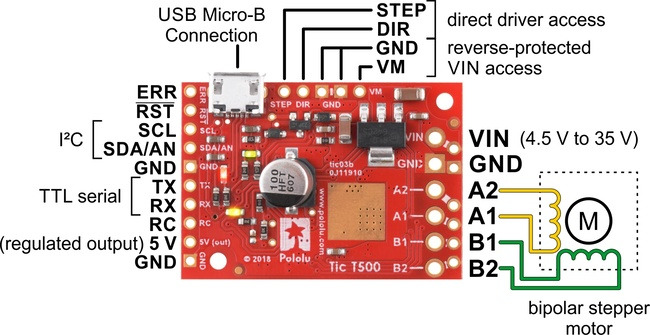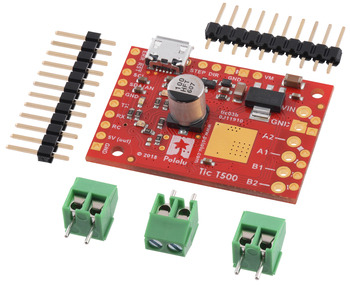Out Of Stock
Notify me when its in stockThe Tic T500 USB Multi-Interface Stepper Motor Controller makes basic control of a stepper motor easy, with quick configuration over USB using our free software. The controller supports six control interfaces: USB, TTL serial, I²C, analog voltage (potentiometer), quadrature encoder, and hobby radio control (RC). This version incorporates an MPS MP6500 driver, and male headers and terminal blocks are included but not soldered. It can operate from 4.5 V to 35 V and can deliver up to approximately 1.5 A per phase without a heat sink or forced air flow (or 2.5 A max with sufficient additional cooling).
The Tic family of stepper motor controllers makes it easy to add basic control of a bipolar stepper motor to a variety of projects. These versatile, general-purpose modules support six different control interfaces: USB for direct connection to a computer, TTL serial and I²C for use with a microcontroller, RC hobby servo pulses for use in an RC system, analog voltages for use with a potentiometer or analog joystick, and quadrature encoder for use with a rotary encoder dial. They also offer many settings that can be configured using our free configuration utility (for Windows, Linux, and macOS). This software simplifies initial setup of the device and allows for in-system testing and monitoring of the controller via USB (a micro-B USB cable is required to connect the Tic to a computer).
The table below lists the members of the Tic family and shows the key differences among them
Features and specifications
New revision (tic03b): As of 3 January 2019, we are shipping a new revision of the Tic T500 that works better with low-resistance, low-inductance stepper motors at high input voltages and high current limits, which could lead to lost steps with the original tic03a version. Please contact us if you have the older version and would like a free replacement.

The Tic T500 is based on the MP6500 IC from Monolithic Power Systems. This driver IC features automatic decay mode selection, using internal current sensing to automatically adjust the decay mode as necessary to provide the smoothest current waveform. The Tic T500 can operate from 4.5 V to 35 V and can deliver up to approximately 1.5 A continuous per phase without a heat sink or forced air flow (the peak current per phase is 2.5 A). This version is sold unassembled so soldering is necessary to use it.
Powering the Tic T500 with a supply voltage between 4.5 V and 5.5 V might cause its logic voltage to be lower than normal, which could affect operation. See the user’s guide for more information.

A version is also available that requires no soldering to use as the terminal blocks and main header pins are already installed.
| Size: | 1.50″ × 1.05″ × 0.42″1 |
|---|---|
| Weight: | 4.8 g1 |
| Model: | Tic T500 |
|---|---|
| Motor driver: | MP6500 |
| Control interface: | USB; non-inverted TTL serial; I²C; RC servo pulses; analog voltage; quadrature encoder |
| Minimum operating voltage: | 4.5 V2 |
| Maximum operating voltage: | 35 V |
| Continuous current per phase: | 1.5 A3 |
| Maximum current per phase: | 2.5 A4 |
| Maximum step rate: | 50000 PPS |
| Microstep resolutions: | full, 1/2, 1/4, and 1/8 |
| Reverse voltage protection?: | Y |
| Connectors soldered?: | N |
| PCB dev codes: | tic03a, tic03b |
|---|---|
| Other PCB markings: | 0J11038, 0J11910 |
Notes
Recommended links
Getting up and running with your Tic stepper motor controller from Pololu is easy. This video will guide you through the basic steps to connect your Tic to its software and control a stepper motor from your computer.
Yes. To avoid damaging your stepper motor, you want to avoid exceeding the rated current, which is 600 mA in this instance. The Tic T825 stepper motor controller has configurable current limiting, so you can set a limit that is appropriate for your stepper motor. As long as you set the limit below the rated current, you will be within spec for your motor, even if the voltage exceeds the rated voltage. The voltage rating is just the voltage at which each coil draws the rated current, so the coils of your stepper motor will draw 600 mA at 3.9 V. By using a higher voltage along with active current limiting, the current is able to ramp up faster, which lets you achieve higher step rates than you could using the rated voltage.
If you do want to use a lower motor supply voltage for other reasons, consider using the Tic T500, which operates from 4.5 V to 35 V, or the Tic T834, which operates from 2.5 V to 10.8 V.